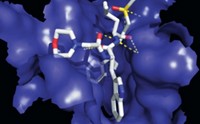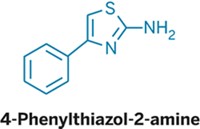Advertisement
Grab your lab coat. Let's get started
Welcome!
Welcome!
Create an account below to get 6 C&EN articles per month, receive newsletters and more - all free.
It seems this is your first time logging in online. Please enter the following information to continue.
As an ACS member you automatically get access to this site. All we need is few more details to create your reading experience.
Not you? Sign in with a different account.
Not you? Sign in with a different account.
ERROR 1
ERROR 1
ERROR 2
ERROR 2
ERROR 2
ERROR 2
ERROR 2
Password and Confirm password must match.
If you have an ACS member number, please enter it here so we can link this account to your membership. (optional)
ERROR 2
ACS values your privacy. By submitting your information, you are gaining access to C&EN and subscribing to our weekly newsletter. We use the information you provide to make your reading experience better, and we will never sell your data to third party members.
Synthesis
Shining Light On Dark Chemical Matter
Drug Discovery: There’s still hope for compounds that haven’t yet shown biological activity in screening assays, study shows
by Celia Henry Arnaud
October 21, 2015
| A version of this story appeared in
Volume 93, Issue 42

Some compounds have never shown biological activity, even after being screened repeatedly in many different drug assays. But such “dark chemical matter,” or DCM, might have biological activity that just hasn’t been identified yet. Scientists at pharmaceutical firm Novartis report in a new article that DCM compounds can still be a promising starting point for discovering drug leads (Nat. Chem. Biol. 2015, DOI: 10.1038/nchembio.1936).
“This article asks an important question,” says Paul Clemons of the Broad Institute, who was not involved with this study but has collaborated with some of the researchers. “Just because we haven’t seen any effect, does that mean we will continue failing to see any effect if we keep looking?”
The Novartis team analyzed the results from more than 650 assays, some from the company’s own drug discovery collection and others from a National Institutes of Health program. They found that 14% of molecules screened in the Novartis assays and 36% of molecules in the NIH assays had never been hits in any test.
The DCM compounds tended to be more soluble and less hydrophobic, with lower molecular weights and with fewer aromatic rings than biologically active compounds. But those physical differences alone don’t explain the lack of activity in DCM molecules, the researchers say.

“Many of the DCM compounds we have identified have no obvious reason that they would, a priori, be inactive in so many of the screens,” says Anne Mai Wassermann, a former postdoc at Novartis who’s now at Pfizer. “These DCM compounds are not dramatically different in structure from compounds that are commonly identified as hits.” Indeed, almost all of the substructural features in “dark” compounds can be found in active compounds, she says.
And just because a compound has not yet been active in a biological assay doesn’t mean that will be the case for all future assays. The Novartis team tested DCM compounds in several of the firm’s assays and identified four DCM compounds with antifungal activity.
“This work has increased the visibility of DCM compounds with respect to how they are viewed as potentially unique or privileged when they hit in an assay,” says John W. Davies, head of in silico lead discovery at Novartis.
“It is our hope that they may be specific to a particular target class or uniquely selective in their mechanism of action,” says Meir Glick, who led the study at Novartis but is now cheminformatics director at Merck & Co.
DCM compounds are on the opposite end of the continuum from a troublesome group of molecules called pan assay interference compounds, or PAINS, which frequently register as hits during assays—and which are often false positives.
“Flagging compounds as DCM may prove useful in high-throughput screening to highlight potential opportunity, just as the noting of compounds as PAINS can be used to highlight potential for severe risk,” says Michael A. Walters, a high-throughput screening expert at the University of Minnesota, Twin Cities.
In screening DCM compounds, “there is a relatively high risk you may not get a hit,” says Jonathan B. Baell, a screening expert at Monash University. “But if you do, the presumed selectivity is then very valuable.”
This article has been translated into Spanish by Divulgame.org and can be found here.




Join the conversation
Contact the reporter
Submit a Letter to the Editor for publication
Engage with us on Twitter